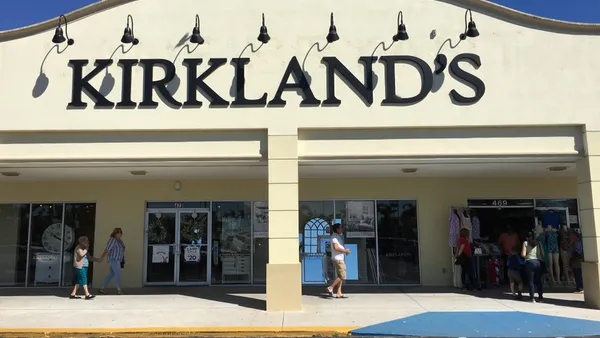Dive Brief:
- As Sears Holdings looks to restructure some $1 billion in debt, S&P Global Ratings downgraded the retailer's corporate rating to CCC- from CCC, according to a Thursday press release from S&P emailed to Retail Dive. A Sears spokesperson did not reply to a request for comment on the downgrade.
- Analysts with the ratings agency said that "we will likely view an eventual transaction as distressed and tantamount to a default if completed." While noting Sears had not disclosed details of its discussions with lenders, S&P analysts said that "we believe lenders would receive less than the original promise" attached to the debt. More specifically, they said "the potential transactions would include reducing cash interest payment and extending on some of its debt maturities."
- Moody's on Jan. 15 also issued a report noting that Sears' talks with lenders could result in a distressed debt exchange, which analysts viewed as a "credit negative." Sears said earlier in January that it was working on an agreement to improve terms in its $1 billion non-first lien debt. CEO Eddie Lampert said in a blog post that if the retailer could not negotiate a refinancing agreement, it would "consider all other options to maximize the value of Sears Holdings' assets."
Dive Insight:
Sears said in January it was committed to becoming profitable again this year. Its road toward black ink, however, still looks long and uncertain.
For one, it had an alarmingly terrible holiday sales season. The retailer said in January that comparable store sales at Sears and Kmart for the first two months of the fourth quarter — which includes the holiday season — were down 16% to 17%. That figure included reductions in some store pharmacies and electronics products, but even with those effects excluded, comps were still down around 15%.
And while Sears' sales sank, other department store retailers — including Kohl's, J.C. Penney and Macy's — reported much-needed sales increases for November and December. The holiday rebound for department stores left Sears behind.
For Q4, Sears now expects a net loss to shareholders of $200 million to $320 million. That represents a hefty improvement over the $607 million Sears lost in the year-ago period, but it's still a ton of money.
The company said it has found another $200 million in corporate cost cuts — though it hasn't elaborated on what those consist of — and it's started the year with plans to close 100 more stores. To keep operations afloat, the retailer has also recently borrowed another $100 million from Lampert's hedge fund.
In other words, Sears in 2018 so far looks a lot like Sears in 2017, and Sears in 2016, and so on.
Sears has been able to stave off default for years largely through store closures (there have been around 400 in the past year alone), staff layoffs (numbering in the hundreds in 2017), asset sales, loan extensions and loans from Lampert's hedge fund ESL Investments, which provided hundreds of millions of dollars in credit in 2017. To try to revive sales, it's also partnered with Amazon to sell Kenmore products, tested new store formats and revived its holiday catalog.
The dwindling sales might be the biggest problem for Sears in the long run. A retailer can only cut costs and close stores so much and remain viable. And there seems to be no end in sight to the customer bleeding.
Moody's analysts wrote in mid-January that they expect Sears' business "will continue to suffer considerable operating losses that will need to be funded." They added, "Although the company has alternative assets to enhance its liquidity, a more comprehensive refinancing will be required this year to avoid a bankruptcy filing."














